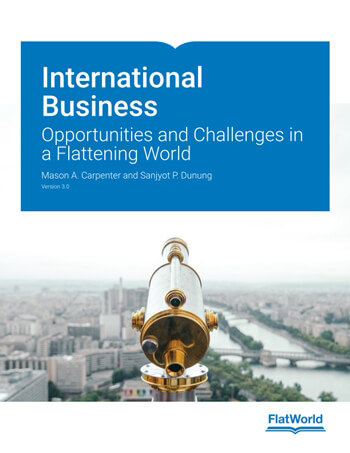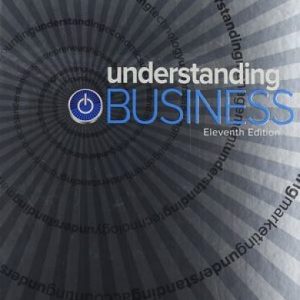This is completed downloadable of International Business Opportunities and Challenges in a Flattening World Version 3 0 3rd Carpenter Solution Manual

Product Details:
- ISBN-10 : 145338684X
- ISBN-13 : 978-1453386842
- Author:
When purchased from FlatWorld (the publisher), this Color Print Textbook includes Online Access, Quizzes, Flashcards and Homework (if professor uses Homework system). Online textbook is accessible. This textbook not only provides the foundation for the subject, but also helps today’s learners understand what is really relevant in today’s constantly changing global business arena. The authors stress the importances of seeing borders as bridges, and not barriers, as they encourage entrepreneurship and discuss strategy.
Table of Content:
- Chapter 1: Introduction
- 1.1: What Is International Business?
- The Definition of International Business
- Strategic Management and Entrepreneurship
- 1.2: Who Is Interested in International Business?
- The Stakeholders
- 1.3: What Forms Do International Businesses Take?
- The Forms of International Business
- International Forms of Government
- Nongovernmental Organizations
- 1.4: The Globalization Debate
- We Live in a Flat World
- The Mumbai Taxman
- Chris C. Got it Wrong?
- How the World Got Flat
- We Live in a Multidomestic World, Not a Flat One!
- 1.5: Ethics and International Business
- A Framework for Ethical Decision Making
- What Ethics Is Not
- 1.6: End-of-Chapter Questions and Exercises
- Endnotes
- Chapter 2: International Trade and Foreign Direct Investment
- 2.1: What Is International Trade Theory?
- What Is International Trade?
- What Are the Different International Trade Theories?
- Classical or Country-Based Trade Theories
- Mercantilism
- Absolute Advantage
- Comparative Advantage
- Heckscher-Ohlin Theory (Factor Proportions Theory)
- Leontief Paradox
- Modern or Firm-Based Trade Theories
- Country Similarity Theory
- Product Life Cycle Theory
- Global Strategic Rivalry Theory
- Porter’s National Competitive Advantage Theory
- Which Trade Theory Is Dominant Today?
- 2.2: Political and Legal Factors That Impact International Trade
- What Are the Different Political Systems?
- What Are the Different Legal Systems?
- Government—Business Trade Relations: The Impact of Political and Legal Factors on International Tr
- Why Do Governments Intervene in Trade?
- How Do Governments Intervene in Trade?
- 2.3: Foreign Direct Investment
- Understand the Types of International Investments
- Factors That Influence a Company’s Decision to Invest
- Why and How Governments Encourage FDI
- How Governments Discourage or Restrict FDI
- How Governments Encourage FDI
- 2.4: Tips in Your Entrepreneurial Toolkit
- Attracting Trade and Investment
- 2.5: End-of-Chapter Questions and Exercises
- Endnotes
- Chapter 3: Culture and Business
- 3.1: What Is Culture, Anyhow? Values, Customs, and Language
- So, What Is Culture, Anyway?
- What Kinds of Culture Are There?
- Nationalities
- Subcultures
- Organizations
- 3.2: What Are the Key Methods Used to Describe Cultures?
- Hofstede and Values
- Edward T. Hall
- Context: High-Context versus Low-Context Cultures
- Space
- Attitudes toward Time: Polychronic versus Monochronic Cultures
- What Else Determines a Culture?
- Communication
- Verbal Language
- Body Language
- Ethnocentrism
- 3.3: Understanding How Culture Impacts Local Business Practices
- 3.4: Global Business Ethics
- Global Business Ethics
- Where Do Our Values Come From?
- Impact of Ethics on Global Business
- Ethics and Management Practices
- Ethics and Corruption
- Ethics in Action
- Corporate Social Responsibility
- Enforcement of Ethical Guidelines and Standards
- The Evolution of Ethics
- 3.5: Tips in Your Entrepreneurial Toolkit
- Conducting Business and Negotiating
- 3.6: End-of-Chapter Questions and Exercises
- 3.7: Additional References
- Endnotes
- Chapter 4: World Economies
- 4.1: Classifying World Economies
- Classification of Economies
- Statistics Used in Classifications
- Gross Domestic Product
- Purchasing Power Parity
- Human Development Index (HDI)
- Why Does All This Matter to Global Business?
- 4.2: Understanding the Developed World
- The Developed World
- The United States
- European Union
- Spotlight on Germany
- Japan
- 4.3: Developing World
- The Developing World
- Major Developing Economies and Regions
- The Middle East
- Spotlight on the UAE
- Africa
- Spotlight on Nigeria
- How Do Developing Countries Become Emerging Markets?
- 4.4: Emerging Markets
- What Exactly Is an Emerging Market?
- Key Emerging Markets
- Asia
- Spotlight on China
- Spotlight on India
- Europe
- Spotlight on Russia
- Africa
- Spotlight on South Africa
- Latin America
- Spotlight on Brazil
- 4.5: Tips in Your Entrepreneurial Toolkit
- Researching the Local Market
- 4.6: End-of-Chapter Questions and Exercises
- Endnotes
- Chapter 5: Global and Regional Economic Cooperation and Integration
- 5.1: International Economic Cooperation among Nations
- General Agreement on Tariffs and Trade (GATT)
- World Trade Organization (WTO)
- Brief History and Purpose
- Current Challenges and Opportunities
- Future Outlook
- 5.2: Regional Economic Integration
- What Is Regional Economic Integration?
- Pros
- Cons
- Major Areas of Regional Economic Integration and Cooperation
- North America: NAFTA
- Brief History and Purpose
- Current Challenges and Opportunities
- Future Outlook
- South America: MERCOSUR
- Other Trade Agreements in the Americas
- Caribbean Community and Andean Community
- CAFTA-DR
- Europe: EU
- Brief History and Purpose
- EU Governance
- Current Challenges and Opportunities
- Future Outlook
- Asia: ASEAN
- Asia: APEC Trade Agreement
- Middle East: GCC
- Middle East and Africa: AEC
- How Do These Trade Agreements and Efforts Impact Business?
- 5.3: The United Nations and the Impact on Trade
- Why Does Peace Impact Business?
- Did You Know?
- The United Nations
- UN as a Buyer and Business Partner
- 5.4: End-of-Chapter Questions and Exercises
- Endnotes
- Chapter 6: International Monetary System
- 6.1: What Is the International Monetary System?
- Pre–World War I
- The Advantages of the Gold Standard
- Collapse of the Gold Standard
- Post–World War II
- Bretton Woods
- Fixed Exchange Rates
- National Flexibility
- Creation of the International Monetary Fund and the World Bank
- Collapse of Bretton Woods
- Post–Bretton Woods Systems and Subsequent Exchange Rate Efforts
- Jamaica Agreement
- The Gs Begin
- Today’s Exchange Rate System
- 6.2: What Is the Role of the IMF and the World Bank?
- International Monetary Fund
- History and Purpose
- Special Drawing Rights (SDRs)
- The IMF’s Current Role and Major Challenges and Opportunities
- Criticism and Challenging Areas for the IMF
- Opportunities and Future Outlook for the IMF
- The World Bank and the World Bank Group
- History and Purpose
- What Are the World Bank’s Current Role and Major Challenges and Opportunities?
- Opportunities and Future Outlook for the World Bank
- 6.3: Understanding How International Monetary Policy, the IMF, and the World Bank Impact Business Pr
- How Business Is Impacted by the Current Monetary Environment, the IMF, and the World Bank
- Working in the International Development Arena with a Business Background
- 6.4: Tips in Your Entrepreneurial Toolkit
- Are You Interested in Jobs in the Development Arena?
- 6.5: End-of-Chapter Questions and Exercises
- Endnotes
- Chapter 7: Foreign Exchange and the Global Capital Markets
- 7.1: What Do We Mean by Currency and Foreign Exchange?
- What Are Currency and Foreign Exchange?
- What Is the Purpose of the Foreign Exchange Market?
- Currency Conversion
- Currency Hedging
- Currency Arbitrage
- Currency Speculation
- Understand How to Determine Exchange Rates
- How to Quote a Currency
- Direct Currency Quote and Indirect Currency Quote
- Spot Rates
- Cross Rates
- Forward Rates
- Swaps, Options, and Futures
- Exchange-Traded and Standardized Terms
- Settlement and Delivery
- Maturity
- 7.2: Understanding International Capital Markets
- What Are International Capital Markets?
- Major Components of the International Capital Markets
- International Equity Markets
- International Bond Markets
- Foreign Bond
- Eurobond
- Global Bond
- Eurocurrency Markets
- Offshore Centers
- The Role of International Banks, Investment Banks, Securities Firms, and Global Financial Firms
- 7.3: Venture Capital and the Global Capital Markets
- 7.4: Tips in Your Entrepreneurial Toolkit
- Dealing with Venture Capitalists
- 7.5: End-of-Chapter Questions and Exercises
- Endnotes
- Chapter 8: International Expansion and Global Market Opportunity Assessment
- 8.1: Global Strategic Choices
- The Why, Where, and How of International Expansion
- Rationale for International Expansion
- Planning for International Expansion
- International Market Due Diligence
- Regional Differences
- Understanding Local Consumers
- How to Learn the Needs of a New Foreign Market
- Differentiation and Capability
- Industry Dynamics
- Steps and Missteps in International Expansion
- 8.2: PESTEL, Globalization, and Importing
- Know the Components of PESTEL Analysis
- Political Factors
- Economic Factors
- Sociocultural Factors
- Technological Factors
- Environmental Factors
- Legal Factors
- PESTEL and Globalization
- Markets
- Costs
- Governments and Competition
- Importing as a Stealth Form of Internationalization
- 8.3: International-Expansion Entry Modes
- The Five Common International-Expansion Entry Modes
- Exporting
- Licensing and Franchising
- Partnerships and Strategic Alliances
- Acquisitions
- New, Wholly Owned Subsidiary
- 8.4: CAGE Analysis
- The Inputs into CAGE Analysis
- CAGE Analysis and Institutional Voids
- Three Strategies for Handling Institutional Voids
- 8.5: Scenario Planning and Analysis
- The History and Role of Scenario Planning and Analysis
- Scenario Planning
- Trends and Uncertainties
- 8.6: End-of-Chapter Questions and Exercises
- Endnotes
- Chapter 9: Exporting, Importing, and Global Sourcing
- 9.1: What Are Importing and Exporting?
- What Do We Mean by Exporting and Importing?
- Why Do Companies Export?
- Benefits of Exporting: Vitrac
- Risks of Exporting
- Specialized Entry Modes: Contractual
- Licensing
- Franchising
- Specialized Entry Modes: Investment
- Joint Ventures
- Risks of Joint Ventures
- Wholly Owned Subsidiaries
- Cautions When Purchasing an Existing Foreign Enterprise
- Building Long-Term Relationships
- Conclusion
- 9.2: Countertrade
- What Is Countertrade?
- Why Do Companies Engage in Countertrade?
- Structures in Countertrade
- Disadvantages of Countertrade
- 9.3: Global Sourcing and Its Role in Business
- What Is Global Sourcing?
- Best Practices in Global Sourcing
- Judging Quality from Afar: ISO 9000 Certification
- Trends in Sourcing: Considering Carbon Costs
- Outsourcing versus Global Sourcing
- The Hidden Costs of Outsourcing
- Managing Outsourced Services
- Entrepreneurial Opportunities from Outsourcing
- 9.4: Managing Export and Import
- Who Are the Main Actors in Export and Import?
- Role of Intermediaries
- What’s Needed for Import and Export Transactions?
- 9.5: What Options Do Companies Have for Export and Import Financing?
- How Companies Receive or Pay for Goods and Services
- Basics of Export Financing
- Success Tips for Entrepreneurs
- The Role of Organizations in Providing Financing
- 9.6: Tips in Your Entrepreneurial Toolkit
- Negotiating for Success across Cultures
- 9.7: End-of-Chapter Questions and Exercises
- Endnotes
- Chapter 10: Strategy and International Business
- 10.1: Business and Corporate Strategy
- What Is Strategy?
- The Strategizing Process
- The Fundamentals of SWOT Analysis
- Strengths and Weaknesses
- Opportunities and Threats
- 10.2: Generic Strategies
- Types of Business-Level Strategies
- Cost-Leadership Strategy
- Differentiation Strategy
- Integrated Cost-Leadership/Differentiation Strategy
- Types of Corporate Strategy
- Vertical Scope
- Horizontal Scope
- Economies of Scale, Economies of Scope, Synergies, and Market Power
- Geographic Scope
- Economies of Scale, Economies of Scope, or Reduction in Costs
- 10.3: International Strategy
- Multidomestic Strategy
- Global Strategy
- Transnational Strategy
- International Strategy and the Local Environment
- 10.4: The Five Elements of Strategy
- Arenas
- Differentiators
- Vehicles
- Staging and Pacing
- Economic Logic
- The Five Elements and International Strategy
- 10.5: Managing the International Business with the P-O-L-C Framework
- Planning
- Strategic Planning
- Tactical Planning
- Operational Planning
- Organizing
- Leading
- Controlling
- 10.6: End-of-Chapter Questions and Exercises
- Endnotes
- Chapter 11: Global Entrepreneurship and Intrapreneurship
- 11.1: Entrepreneurship
- Entrepreneurship and Entrepreneurs
- So You Want to Be an Entrepreneur?
- Truths and Myths about Entrepreneurs
- Should You Become an Entrepreneur?
- Entrepreneurship and the Changing Nature of “Corporate” Life
- 11.2: What Do Entrepreneurs Do?
- What Do Entrepreneurs Do?
- What Is the Entrepreneurial Process?
- Taking the Opportunity
- How Do People Find Opportunities?
- Low-End Disruption
- New-Market Disruption
- Hybrid-Disruption Strategies
- The Business Plan
- Resourcing the New Venture Plan with People, Money, and Action
- People
- Money
- Action
- 11.3: Business Entrepreneurship across Borders
- How the Ease of Doing Business Affects Entrepreneurship across Countries
- Differing Attitudes about Entrepreneurship around the World
- 11.4: From Entrepreneurship to Born-Global Firms
- Global Start-ups and Born-Global Firms
- Two Phases of Global Start-up Assessment
- 11.5: From Entrepreneurship to Intrapreneurship
- Intrapreneurship and Its Roots
- Differences between Entrepreneurs and Intrapreneurs
- Intrapreneurship in Action
- The Intrapreneurial Organization
- The Coexistence Approach
- The Structural-Separation Approach
- 11.6: End-of-Chapter Questions and Exercises
- Endnotes
- Chapter 12: Winning through Effective, Global Talent Management
- 12.1: The Changing Role of Strategic Human Resources Management in International Business
- HR as a Strategic Partner
- Crucial Role of SHRM in Global Firms
- The Importance of Human Capital
- Focus on Outcomes
- Key Elements of HRM
- Selection and Placement
- Job Design
- Compensation and Rewards
- Diversity Management
- 12.2: The Global War for Talent
- What Talent Management Means
- Attracting the Right Workers to the Organization
- Keeping Star Employees
- What Employees Want
- Benefits of Good Talent Management
- 12.3: Effective Selection and Placement Strategies
- Job-Description Best Practices
- Tailoring Recruitment to Match Company Culture
- Organized Labor and International Business
- Tools and Methods: Interviewing and Testing
- International Staffing and Placement
- 12.4: The Roles of Pay Structure and Pay for Performance
- Compensation Design Issues for Global Firms
- Pay System Elements
- Setting Pay Levels
- Pay for Performance
- Innovative Employee-Recognition Programs
- Pay Structures for Groups and Teams
- Gainsharing
- Team-Based Pay
- Pay Systems that Reward Both Team and Individual Performance
- 12.5: Tying It All Together—Using the HRM Balanced Scorecard to Gauge and Manage Human Capital, In
- Applying the Balanced Scorecard Method to HRM
- Applying the Balanced Scorecard Method to HRM
- Human Capital
- The Payoff
- 12.6: Tips in Your Entrepreneurial Toolkit
- Applying the Balanced Scorecard Method to Your Human Capital
- 12.7: End-of-Chapter Questions and Exercises
- Endnotes
- Chapter 13: Harnessing the Engine of Global Innovation
- 13.1: An Introduction to Research and Development (R&D)
- History and Importance
- The Role of Government
- 13.2: Intellectual Property Rights around the Globe
- Intellectual Property Rights
- Licensing IP Rights
- IP Protection Varies by Country
- WIPO
- 13.3: How to Organize and Where to Locate Research and Development Activities
- How to Organize R&D Activities
- Deciding Where to Locate R&D Activities
- 13.4: Increasing Speed and Effectiveness of International Innovation
- Process Innovations
- Open Innovation
- Innovation Contests
- Role of Intrapreneurship in Corporate Innovation
- User-Led Innovation
- Social Networks
- 13.5: Innovation for the Bottom of the Pyramid
- Contemporary View of BOP
- Twelve Principles of BOP Innovation
- 13.6: End-of-Chapter Questions and Exercises
- Endnotes
- Chapter 14: Competing Effectively through Global Marketing, Distribution, and Supply-Chain Managemen
- 14.1: Fundamentals of Global Marketing
- The Four Ps
- The Marketing Mix
- Market Segmentation
- Understanding Your Target Customers
- Rising Middle Class
- Millionaires Are Everywhere
- Emerging Markets for Business Customers
- Global Market Research
- Dealing with Gray and Counterfeit Markets
- 14.2: Critical Decision Points in Global Marketing
- Global Branding
- Acer’s Multiple-Brand Strategy
- Global Brand Web Strategy
- Planning a Brand Strategy for Emerging Markets
- Branding Issues: How Low Can You Go?
- Centralized versus Decentralized Marketing Decisions
- 14.3: Standardized or Customized Products
- Straight Product Extension
- Product Adaptation
- Product Invention: P&G Diapers
- Nuances of Product Extension, Adaptation, and Invention
- Country-of-Origin Effect
- Reverse Innovation: How Designing for Emerging Economies Brings Benefits Back Home
- 14.4: Global Sourcing and Distribution
- Distribution Management
- How Nokia Tackles Distribution Challenges
- Distribution-Management Choices: Partner, Acquire, or Build from Scratch
- 14.5: Global Production and Supply-Chain Management
- Strategic Choices: Export, Local Assembly, and Local Production
- Manufacture in the United States and Then Export
- Global Components with Local Assembly
- Local Production
- Government Incentives
- Infrastructure Issues
- Offshoring and Outsourcing
- Supply-Chain Management
- 14.6: End-of-Chapter Questions and Exercises
- Endnotes
- Chapter 15: Understanding the Roles of Finance and Accounting in Global Competitive Advantage
- 15.1: International Accounting Standards
- The Role of Accounting in International Business
- The Emergence of New International Accounting Standards
- Characteristics of International Accounting Standards and Their Implications for International Busin
- 15.2: Accounting in International Business
- Financial Statements in International Business
- Currency Risk
- Currency Translation
- Current-Rate Method
- Temporal Method
- Currency Fluctuations
- Forward Exchange Rate
- 15.3: Fundamentals of Finance
- Financial Structure and Sources of Financing
- Financing Options Available to Subsidiaries
- Raising Money in Overseas Equity Markets
- Raising Money in Overseas Debt Markets
- Investment Decisions
- Capital Budgeting
- How Government Actions Affect Investment Decisions
- Indonesia
- The Role of Government
- 15.4: Financial Management in International Business
- Accounting for Political and Economic Risk
- Increased Volatility
- Legal Infrastructure: Challenges of Nascent Laws
- Financial Organizational Structure in International Business
- Centralized Structures
- Decentralized Structures
- Communication with Headquarters
- Hybrid Financial Organization Structures
- The Impact of Religion: Islamic Finance
- 15.5: Global Money Management: Moving Money across Borders
- Global Money Management and Centralized Depositories
- Cash Management
- Multilateral Netting
- Tax Advantages of Fronting Loans
- Transfer Pricing
- Indirect Taxes
- 15.6: End-of-Chapter Questions and Exercises
- Endnotes
- Index





